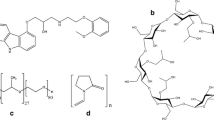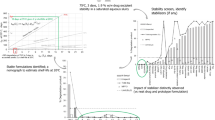Abstract
The focus of the present work was to investigate compatibility between commonly used diluents and the drug (salt and acid form of the phenytoin). Lactose monohydrate (LMH), lactitol hydrate (LCT), and mannitol (MNT) were selected based on commercial products information of phenytoin sodium (PS) and phenytoin acid (PHT). Binary mixtures of the drug-diluent were stored at 60°C and 40°C/75% RH. Similarly, two commercial products, namely Product-A and Product-B, were also investigated in in-use stability. Color of PS-LMH changed from white to yellowish-brown and pH dropped by 3.4 units after 4 weeks exposure. FTIR, XRPD, and NIR chemical images indicated disproportionation in PS-LMH and PS-LCT mixtures stored at 40°C/75% RH. Furthermore, PS-LMH also indicated chemical interactions as indicated by distortion of LMH peaks. PHT-diluent mixture did not exhibit any physical and chemical modifications. Product-A changed color, increased weight, dropped pH value, and exhibited disproportionation and chemical reactions. The dissolution of Product-A decreased from 83.3 ± 1.4 to 7.1 ± 4.4% on 8 weeks exposure to 30°C/75% RH. On the other hand, Product-B did not change; however, dissolution decreased by 15%. In conclusion, PS showed disproportionation and chemical reactions with LMH. Therefore, LMH should be avoided in PS formulations.











Similar content being viewed by others
References
Pifferi G, Santoro P, Pedrani M. Quality and functionality of excipients. Il Farmaco. 1999;54 (1–2):1–14.
USP guideline for submitting requests for revision to USP-NF - Submission guideline for excipients, 2016. http://www.usp.org/sites/default/files/usp/document/get-involved/submission-guidelines/excipients_rfr_guideline-28apr16.pdf. Accessed 5 Dec 2018.
Hentzschel CM, Sakmann A, Leopold CS. Comparison of traditional and novel tableting excipients: physical and compaction properties. Pharm Dev Technol. 2012;17:649–53.
Ilić I, Govedarica B, Šibanc R, Dreu R, Srčič S. Deformation properties of pharmaceutical excipients determined using an in-die and out-die method. Int J Pharm. 2013;25:6–15.
Patel S, Kaushal AM, Bansal AK. Compression physics in the formulation development of tablets. Crit Rev Ther Drug Carrier Syst. 2006;23:1–65.
Wax PM. Elixirs, diluents, and the passage of the 1938 Federal Food, Drug and Cosmetic Act. Ann Intern Med. 1995:456–61.
Bundgaard H. Polymerization of penicillins: kinetics and mechanism of di- and polymerization of ampicillin in aqueous solution. Acta Pharma Suec. 1976;13:9–26.
Pifferi G, Restani P. The safety of pharmaceutical excipients. Farmaco. 2003;58:541–50.
Cavatur R, Chrzan Z, Vemuri NM. Use of isothermal microcalorimetry in pharmaceutical preformulation studies part III. Evaluation of excipients compatibility of a new chemical entity. J Therm Anal Cal. 2004;78:63–72.
Rahman Z, Dharani S, Barakh Ali SF, Afrooz H, Reddy IK, Khan MA. Effect of processing parameters and controlled environment storage on the disproportionation and dissolution of extended-release capsule of phenytoin sodium. Int J Pharm. 2018;25:290–9.
Horiuchi S, Ikeda K, Kayashima K, Mizutari K, Ono T. Photo enhanced modification of human skin elastin in actinic elastosis by N-(carboxymethyl)lysine, one of the glycoxidation products of the Maillard reaction. J Investig Dermatol. 1997;108:792–802.
Block LH, Pankaj R, Sabnis S. Use of chitosan in compressed tablets of diclofenac sodium: inhibition of drug release in an acidic environment. Pharm Dev Technol. 1997;2:243–55.
Vranić E. Basic principles of drug--excipients interactions. Bosn J Basic Med Sci. 2004;4:56–8.
Hartauer KJ, Arbuthnot GN, Baertschi SW, Johnson RA, Luke WD, Pearson NG, et al. Influence of peroxide impurities in povidone and crospovidone on the stability of raloxifene hydrochloride in tablets: identification and control of an oxidative degradation product. Pharm Dev Technol. 2000;5:303–10.
Wu Y, Dali M, Gupta A, Raghavan K. Understanding drug-excipient compatibility: oxidation of compound A in a solid dosage form. Pharm Dev Technol. 2009;14:556–64.
Hildebrandt C, Joos L, Saedler R, Winter G. The “New Polyethylene Glycol Dilemma”: polyethylene glycol impurities and their paradox role in mAb crystallization. J Pharm Sci. 2015;104:1938–45.
Barakh DS, Ali SF, Afrooz H, Bhattacharya R, Khan MA, Rahman Z. Quality and in-use stability comparison of brand and generics of extended-release phenytoin sodium capsules. J Pharm Sci. 2019;108:1808–17.
Hsieh YL, Taylor LS. Salt stability-effect of particle size, relative humidity, temperature and composition on salt to free base conversion. Pharm Res. 2015;32:549–61.
Christensen NPA, Rantanen J, Cornett C, Taylor LS. Disproportionation of the calcium slat of atorvastatin in the presence of acidic excipients. Eur J Pharm Biopharm. 2012;82:410–6.
Guerrieri P, Taylor L. Role of salt and excipient properties on disproportionation in the solid-state. Pharm Res. 2009;26:2015–26.
Bochner F, Hooper WD, Tyrer JH, Eadie MJ. Factors involved in an outbreak of phenytoin intoxication. J Neurol Sci. 1972;16:481–7.
Monajjemzadeh F, Hassanzadeh D, Valizadeh H, Siahi-Shadbad MR, Mojarrad JS, Robertson T, et al. Assessment of feasibility of Maillard reaction between baclofen and lactose by liquid chromatography and tandem mass spectrometry, application to pre formulation studies. AAPS PharmSciTech. 2009;10:649–59.
Li S, Patapoff TW, Overcashier D, Hsu C, Nguyen TH, Borchardt RT. Effects of reducing sugars on the chemical stability of human relaxin in the lyophilized state. J Pharm Sci. 1996;85:873–7.
Amaral Silva D, Löbenberg R, Davies NM. Are excipients inert? Phenytoin pharmaceutical investigations with new incompatibility insights. J Pharm Pharm Sci. 2018;21:29745.
Sherif IFB, Munir AH. Microenvironmental pH modulation in solid dosage forms. J Pharm Sci. 2007;96:948–59.
Dharani S, Rahman Z, Barakh Ali SF, Afrooz H, Khan MA. Quantitative estimation of phenytoin sodium disproportionation in the formulations using vibration spectroscopies and multivariate methodologies. Int J Pharm. 2018;25:65–74.
ICH harmonized tripartite guideline- validation of analytical procedures: text and methodology Q2(R1), 2005. https://database.ich.org/sites/default/files/Q2_R1__Guideline.pdf. Accessed 2 Mar 2020.
United States Pharmacopeia 41‐National Formulary 36: Extended phenytoin capsules monograph. Rockville, MD; 2018. p. 3290.
United States Pharmacopeia 41‐National Formulary 36: phenytoin chewable tablets monograph. Rockville, MD; 2018. p. 3287.
Nguyenpho A, Ciavarella AB, Siddiqui A, Rahman Z, Akhtar S, Hunt R, et al. Evaluation of in-use stability of anticoagulant drug products: warfarin sodium. J Pharm Sci. 2015;104:4232–40.
Browne CA. Moisture absorptive power of different sugars and carbohydrates under varying conditions of atmospheric humidity. Ind Eng Chem. 1922;14:712–3.
Holsinger HH. Lactose. In: Wong PN, Jenness R, Keenay M, Marth EH, editors. Fundamentals of dairy chemistry. 3rd ed. New York: Van Nostrand Reinhold Company; 1988. p. 279.
Wang W, Chen F, Wang Y, Wang L, Fu H, Zheng F, et al. Optimization of reactions between reducing sugars and 1-phenyl-3-methyl-5-pyrazolone (PMP) by response surface methodology. Food Chem. 2018;254:158–64.
Schwartz PA, Rhodes CT, Cooper JW Jr. Solubility and ionization characteristics of phenytoin. J Pharm Sci. 1977;66:994–7.
Ajandouz EH, Puigserver A. Nonenzymatic browning reaction of essential amino acids: effect of pH on caramelization and Maillard reaction kinetics. J Agric Food Chem. 1999;47:1786–93.
Schroeder LJ, Iacobellis M, Smith AH. The influence of water and pH on the reaction between amino compounds and carbohydrates. J Biol Chem. 1955;212:973–84.
Bharate SS, Bharate SB, Bajaj AN. Interactions and incompatibilities of pharmaceutical excipients with active pharmaceutical ingredients: a comprehensive review. J Excipients Food Chem. 2010;1:3–26.
Likar MD, Carroll SC, Colgan ST, Yeoh T, MacDonald BC, Johnson GM, et al. Enhancing the dissolution stability of hard gelatin capsules using activated carbon as a packaging component. J Pharm Sci. 2018;107:3080–8.
Author information
Authors and Affiliations
Corresponding author
Additional information
Publisher’s Note
Springer Nature remains neutral with regard to jurisdictional claims in published maps and institutional affiliations.
Rights and permissions
About this article
Cite this article
Rahman, Z., Dharani, S., Barakh Ali, S.F. et al. Effects of Diluents on Physical and Chemical Stability of Phenytoin and Phenytoin Sodium. AAPS PharmSciTech 21, 104 (2020). https://doi.org/10.1208/s12249-020-1639-x
Received:
Accepted:
Published:
DOI: https://doi.org/10.1208/s12249-020-1639-x




